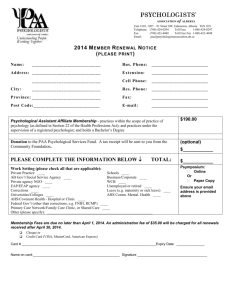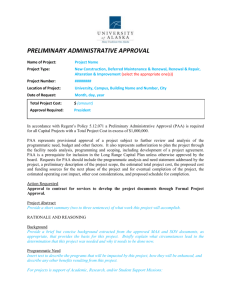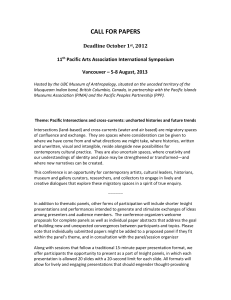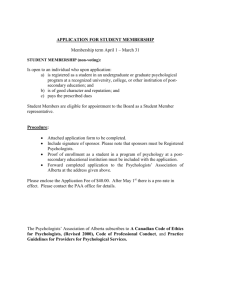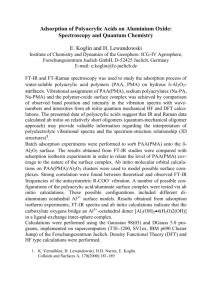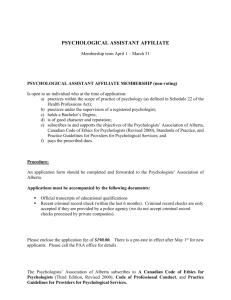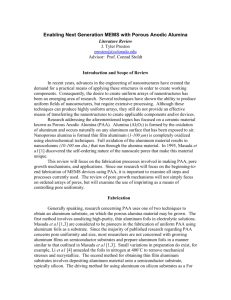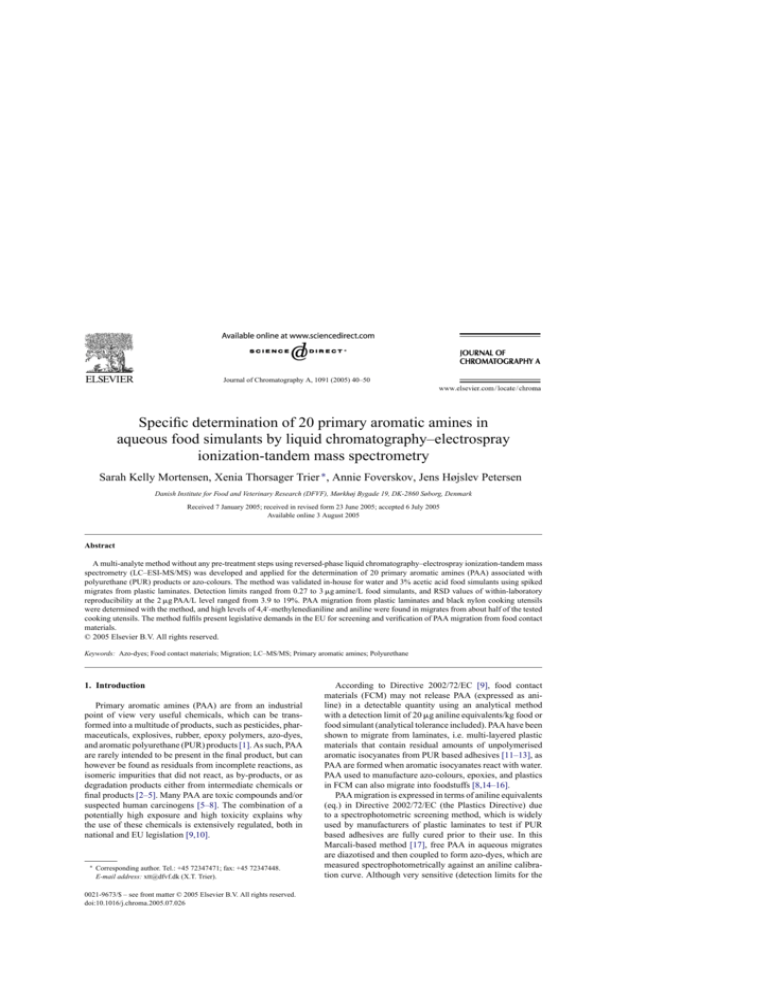
Journal of Chromatography A, 1091 (2005) 40–50
Specific determination of 20 primary aromatic amines in
aqueous food simulants by liquid chromatography–electrospray
ionization-tandem mass spectrometry
Sarah Kelly Mortensen, Xenia Thorsager Trier ∗ , Annie Foverskov, Jens Højslev Petersen
Danish Institute for Food and Veterinary Research (DFVF), Mørkhøj Bygade 19, DK-2860 Søborg, Denmark
Received 7 January 2005; received in revised form 23 June 2005; accepted 6 July 2005
Available online 3 August 2005
Abstract
A multi-analyte method without any pre-treatment steps using reversed-phase liquid chromatography–electrospray ionization-tandem mass
spectrometry (LC–ESI-MS/MS) was developed and applied for the determination of 20 primary aromatic amines (PAA) associated with
polyurethane (PUR) products or azo-colours. The method was validated in-house for water and 3% acetic acid food simulants using spiked
migrates from plastic laminates. Detection limits ranged from 0.27 to 3 g amine/L food simulants, and RSD values of within-laboratory
reproducibility at the 2 g PAA/L level ranged from 3.9 to 19%. PAA migration from plastic laminates and black nylon cooking utensils
were determined with the method, and high levels of 4,4 -methylenedianiline and aniline were found in migrates from about half of the tested
cooking utensils. The method fulfils present legislative demands in the EU for screening and verification of PAA migration from food contact
materials.
© 2005 Elsevier B.V. All rights reserved.
Keywords: Azo-dyes; Food contact materials; Migration; LC–MS/MS; Primary aromatic amines; Polyurethane
1. Introduction
Primary aromatic amines (PAA) are from an industrial
point of view very useful chemicals, which can be transformed into a multitude of products, such as pesticides, pharmaceuticals, explosives, rubber, epoxy polymers, azo-dyes,
and aromatic polyurethane (PUR) products [1]. As such, PAA
are rarely intended to be present in the final product, but can
however be found as residuals from incomplete reactions, as
isomeric impurities that did not react, as by-products, or as
degradation products either from intermediate chemicals or
final products [2–5]. Many PAA are toxic compounds and/or
suspected human carcinogens [5–8]. The combination of a
potentially high exposure and high toxicity explains why
the use of these chemicals is extensively regulated, both in
national and EU legislation [9,10].
∗
Corresponding author. Tel.: +45 72347471; fax: +45 72347448.
E-mail address: xtt@dfvf.dk (X.T. Trier).
0021-9673/$ – see front matter © 2005 Elsevier B.V. All rights reserved.
doi:10.1016/j.chroma.2005.07.026
According to Directive 2002/72/EC [9], food contact
materials (FCM) may not release PAA (expressed as aniline) in a detectable quantity using an analytical method
with a detection limit of 20 g aniline equivalents/kg food or
food simulant (analytical tolerance included). PAA have been
shown to migrate from laminates, i.e. multi-layered plastic
materials that contain residual amounts of unpolymerised
aromatic isocyanates from PUR based adhesives [11–13], as
PAA are formed when aromatic isocyanates react with water.
PAA used to manufacture azo-colours, epoxies, and plastics
in FCM can also migrate into foodstuffs [8,14–16].
PAA migration is expressed in terms of aniline equivalents
(eq.) in Directive 2002/72/EC (the Plastics Directive) due
to a spectrophotometric screening method, which is widely
used by manufacturers of plastic laminates to test if PUR
based adhesives are fully cured prior to their use. In this
Marcali-based method [17], free PAA in aqueous migrates
are diazotised and then coupled to form azo-dyes, which are
measured spectrophotometrically against an aniline calibration curve. Although very sensitive (detection limits for the
S.K. Mortensen et al. / J. Chromatogr. A 1091 (2005) 40–50
total concentration of PAA around 1 g aniline eq./kg), the
complexity of the diazo-coupling reactions results in a lack
of robustness towards small changes in experimental conditions [18,19], in varying sensitivity to individual PAA, in the
risk of positive or negative interferences, and the risk of producing false positives. From a legislative point of view, the
use of such an unspecific method for compliance testing is
unsatisfactory. Therefore, there is an obvious need for specific verification methods, which are able to detect PAA well
below the sum limit of 20 g aniline eq./kg and determine if
the detected PAA species are on the FCM positive list or not.
In response to this demand, a task force in the FCM division of the European Committee for Standardization (CEN
194/SC1, WG2/TG 9) has worked for the past few years
with the development and standardisation of methods for
the enforcement of the PAA migration limits set in Directive
2002/72/EC. They recently suggested that the spectrophotometric method should only be used for screening purposes
and that PAA sum levels above 2 g aniline eq./kg should be
verified with a specific method. This inspired the development of the present LC–MS/MS method, as well as a number
of other analytical methods: A solid-phase extraction (SPE)
HPLC-UV method for 10 PAA with an integrated pre-column
back-flush procedure [20], and a SPE-GC–MS method in
which eight PAA are derivatised using solid-phase analytical
derivatisation with trifluoroacetic anhydride [21].
PAA methods developed in related fields, such as the
monitoring of environmental waters, which could potentially
be used for testing aqueous FCM simulants include: (1) a
comprehensive SPE-GC–MS method, in which 56 aromatic
amines are derivatised into their iodobenzene equivalents,
thus permitting detection levels in water of 0.5–8 g/L [22];
(2) a solid-phase microextraction GC–MS method for 18
PAA derivatised by diazotation and iodination has also been
used to detect 0.002–0.038 g/L levels in water [23]; and (3)
determination of nitroaromatic explosives and their degradation products in environmental water samples using cartridge
SPE and LC–MS/MS [24].
In comparison to the above-mentioned methods, the
present LC–MS/MS method has the advantage of directly
injecting migrates without any pre-treatment steps, such as
derivatisation or preconcentration. The method was validated
for the determination of PAA in aqueous food simulants at
concentration levels relevant for the enforcement of migration
limits set in the Plastics Directive. Furthermore, the method
has been used to detect PAA migration from plastic laminates as well as nylon (polyamide) cooking utensils made
with black colorants.
2. Experimental
2.1. Chemicals and solvents
Analytical grade standards of the 20 PAA listed in Table 1
were obtained from Acros Organics (Geel, Belgium), TCI
41
America (Portland, OR, USA), Chem Service (West Chester,
PA, USA), Fluka (Buchs, Switzerland) and Riedel-de-Haën
(Seelze, Germany). The purities of the standards are shown
in Table 1. Stock solutions of each compound (500.0 g/mL)
were prepared in analytical grade ethanol from Merck (Darmstadt, Germany), except for 4,4 -DPE, which was dissolved in
acetone from Rathburn Chemicals (Walkerburn, UK). Stock
solutions were stored in a refrigerator for up to 1 year, except
for p-PDA, which was only refrigerated for up to 1 month
because of its instability. Working solution mixtures containing 5.0 g/mL of 9–10 PAA were prepared by diluting stock
solutions with Milli-Q water. These mixtures were stored in a
refrigerator for up to 5 weeks, except for p-PDA that was prepared every 3 days. All solutions were protected from light
by covering their containers with aluminium foil.
Analytical grade methanol was obtained from Fischer Scientific (Loughborough, Leicestershire, UK), glacial acetic
acid was purchased from Merck, and 97% pentafluoropropionic acid (PFPA) was purchased from Acros Organics. Water
was either glass distilled or purified using a Milli-Q purification system from Millipore (Billerica, MA, USA).
2.2. Samples
Four printed laminate samples collected from Danish
manufacturers and importers of multi-layered plastic FCM
between December and January 2002 were used to produce
various matrices for method validation. These samples were
sealed in a moisture-resistant laminate and stored in a freezer
at −20 ◦ C until use. In addition, the method was applied for
the determination of PAA migration from 10 freshly made
laminates collected from Danish manufacturers in August
2004 as well as for 11 different black nylon cooking utensils (i.e. ladles, spoons, skimmers and whisks) purchased at
Danish retail stores on September 28, 2004.
2.3. Migration tests
Freshly produced laminates from August 2004 were permitted to cure at room temperature for a period of 3 days
before being exposed to 3% acetic acid (w/v) in distilled water
at 40 ◦ C for 24 h as well as for 10 days. Single-sided migration tests were conducted for 7 of the 10 laminates by filling
100 mL of 3% acetic acid solution into heat-sealed pouches
with an inner surface area of 2 dm2 according to CEN standard EN 13130-1 [25]. PAA migration was determined in the
remaining three laminates (nos. 5–7) by totally immersing a
10 cm × 10 cm piece of the sample in 100 mL of 3% acetic
acid solution, as these laminates could not be heat-sealed. All
of the tests were performed in triplicate, and a single blank
test was also included by preparing a migration cell that only
contained 100 mL 3% acetic acid.
Laminate samples from 2002 were likewise exposed to
distilled water and 3% acetic acid in single-sided migration tests using heat-sealed pouches with the same volume
to area ratio as described above. Exposure conditions for the
42
Table 1
Compound specific parameters for the 20 PAA included in the method [7,9–10]
IARC
Groupa
Directive
2002/61/ECb
Directive
2002/72/ECc
Time segment
(min)
Retention
time (min)
MRM traces
(m/z)d
Collision
energy (eV)f
106-50-3
>99
3
–
–
1 (1.5–4.8)
2.44
109.1 → 92.2
(109.1 → 65.4)
22
m-Phenylenediamine (m-PDA)
108-45-2
>99
3
–
20 g/kg
2.72
109.1 → 92.2
(109.1 → 65.4)
22
2,6-Toluenediamine (2,6-TDA)
823-40-5
99.9
–
–
+
3.00
123.1 → 108.3
(123.1 → 106.2)
18
4-Methoxy-m-phenylenediaminee
(4-M-mPDA)
615-05-4
–
2B
+
–
3.47
139.1 → 124.1
(139.1 → 107.2)
14
2,4-Toluenediamine (2,4-TDA)
95-80-7
>99
2B
+
+
3.47
123.1 → 108.3
(123.1 → 106.2)
18
Anilinee (ANL)
62-53-3
99
3
–
+
3.71
94.0 → 77.2
(94.0 → 51.3)
18 (30)
o-Anisidine (o-ASD)
90-04-0
>99
2B
+
–
5.03
124.1 → 109.2
(124.1 → 92.3)
14
o-Toluidine (o-T)
95-53-4
>99.5
2A
+
–
5.09
108.1 → 91.4
(108.1 → 93.2)
18
Benzidine (BNZ)
92-87-5
99.5
1
+
–
5.11
184.1 → 156.0
(184.1 → 166.0)
30
4-Chloro-aniline (4-CA)
106-47-8
98
2B
+
–
5.34
128.0 → 93.1
(128.0 → 111.2)
18
4,4 -Diaminodiphenylether (4,4 -DPE)
101-80-4
98
2B
+
+
5.45
201.1 → 108.3
(201.1 → 184.0)
18
4,4 -Methylenedianiline (4,4 -MDA)
101-77-9
97
2B
+
+
6.05
199.1 → 106.2
(199.1 → 77.2)
22 (50)
CAS no.
p-Phenylenediamine (p-PDA)
Structure
2 (4.8–6.3)
S.K. Mortensen et al. / J. Chromatogr. A 1091 (2005) 40–50
Purity
(%)
Name (abbreviation)
Table 1 (Continued )
CAS no.
2,6-Dimethylaniline (2,6-DMA)
87-62-7
2-Methoxy-5-methylaniline
(2-M-5-MA)
IARC
Groupa
Directive
2002/61/ECb
Directive
2002/72/ECc
Time segment
(min)
Retention
time (min)
MRM traces
(m/z)d
Collision
energy (eV)f
99
2B
–
–
3 (6.2–7.0)
6.40
122.1 → 105.3
(122.1 → 107.2)
18
120-71-8
95
2B
+
–
6.59
138.1 → 123.2
(138.1 → 106.2)
14
2,4-Dimethylaniline (2,4-DMA)
95-68-1
99
3
–
–
6.66
122.1 → 107.2
(122.1 → 105.2)
14
4-Chloro-o-toluidine (4-CoT)
95-69-2
98
2A
+
–
6.74
142.0 → 107.2
(142.0 → 125.2)
18
3,3 -Dimethylbenzidinee (3,3 -DMB)
119-93-7
99
2B
+
+
6.77
25
4,4 -Methylenedi-o-toluidine
(4,4 -MDoT)
838-88-0
>95
2B
+
–
212.1 → 196.0
(212.1 → 211.1)
227.2 → 120.2
(227.2 → 178.2)
2,4,5-Trimethylaniline (2,4,5-TMA)
137-17-7
99
3
+
–
7.31
136.1 → 121.3
(136.1 → 119.3)
18
4-Aminobiphenyl (4-ABP)
92-67-1
98.4
1
+
–
7.57
170.1 → 153.2
(170.1 → 152.1)
18
a
b
c
d
e
f
Structure
Purity
(%)
4 (6.9–9.0)
7.03
22
S.K. Mortensen et al. / J. Chromatogr. A 1091 (2005) 40–50
Name (abbreviation)
IARC classification groups: 1 = carcinogenic to humans; 2A = probably carcinogenic to humans; 2B = possibly carcinogenic to humans; 3 = not classifiable as carcinogenic to humans.
List of PAA in the 19th amendment to Directive 76/769/EEC, which restricts the use of azo-dyes that can be reduced to any of the 22 listed aromatic amines.
List of PAA which are either listed as an approved monomer (SML value) or can be derived from the approved aromatic diisocyanates (marked +) listed in Directive 2002/72/EC.
Primary MRM traces used for quantitative purposes are listed first, and secondary MRM traces for verification are in parentheses.
Standards were made from the hydrochloride or dihydrochloride salt of the compound, but calculations were done with reference to the pure compound.
Optimal collision energies were determined for the secondary MRM traces of ANL and 4,4 -MDA and are shown in parentheses.
43
44
S.K. Mortensen et al. / J. Chromatogr. A 1091 (2005) 40–50
Table 2
Types of samples used for method validation: Migrates were produced from
contact between food simulants and food packaging laminates
Type
Matrix
Exposure
time (h)
Temperature
(◦ C)
1
2
3
4
5
Distilled water migrate
Distilled water migrate
Milli-Q water
3% acetic acid migrate
3% acetic acid
24
0.5
–
24
–
20
90
–
40
–
Exposure times and temperatures were chosen according to the intended use
of the laminates. A dash (–) denotes that the matrix was not exposed to any
laminate samples.
migration tests performed with these laminates were chosen
according to the intended use of the food packaging material
and are listed in Table 2.
Nylon cooking utensils were also tested for PAA migration
using 3% acetic acid as a food simulant. All the cooking
utensils were intended for contact with warm food, and they
were washed prior to migration testing. Migration tests for
cooking utensils were performed by immersing the surface
area that is intended for food contact for 2 h at 100 ◦ C. For
the purpose of investigating the long-term migration kinetics
of PAA, the samples were kept immersed at 95 ◦ C in new
portions of the food simulant for 2 × 5 days alternating with
shorter test periods of 2 h and 10 min, respectively, at 100 ◦ C.
2.4. LC–MS/MS analysis
HPLC separation was performed on an Alliance 2695 separation module from Waters (Milford, MA, USA) equipped
with a high-pressure gradient pump and a column heater.
The amines were separated on a Zorbax SB-C3 column
(2.1 mm × 150 mm, 5 m) from Agilent (Palo Alto, CA,
USA) at 40 ◦ C. The sample volume injected was 3 L, and a
0.5 m stainless steel pre-column filter was used to protect the
column from particulates. Optimum separation was achieved
using a gradient composed of solution A (4.7 mM PFPA in
methanol) and solution B (4.7 mM PFPA in Milli-Q water).
The gradient elution program was as follows: 0–3 min, 20%
A at a flow of 200 L/min; 3–7.5 min, a linear increase from
20 to 80% A and from 200 to 500 L/min; 7.5–8 min, 80% A
at 500 L/min; 8–11 min, 5% A at 500 L/min; 11–15 min,
5% A at 200 L/min.
A Quattro Ultima triple quadropole instrument from 1999
(Micromass, Manchester, UK) with Masslynx v. 4.0 software
(Micromass) was used for data acquisition and processing.
Ionisation of the analytes was achieved using an electrospray interface in the positive ion mode (ESI+ ), and ionisation
source parameters were as follows: capillary voltage (Vcap ),
1.0 kV; cone voltage (Vcone ), 20 V; Hex 1 voltage (VHex1 ),
20 V; desolvation temperature, 400 ◦ C; source temperature,
130 ◦ C. Nitrogen was used as nebulising gas (maximum
flow), desolvation gas (flow-rate of 780 L/h), and cone gas
(flow-rate of 40 L/h). Argon was used as collision gas at a
pressure of 2 × 10−3 mbar. Data acquisition was performed
in the multiple reaction monitoring (MRM) mode using either
MH+ or M•+ as the precursor ion. MRM transitions and collision energies for the 20 PAA are listed in Table 1. Each time
segment had three to six MRM traces. The dwell times in
time segments containing three to four ion traces were set to
0.5 s, and time segments with five to six ion traces had dwell
times of 0.2 s.
External calibration standards were used to quantify PAA
levels in migrates from laminate samples. Calibration curves
were constructed with standards containing all 20 PAA in
either Milli-Q water or 3% acetic acid at concentrations
of 0.5, 2, 5, 10, 15, 25, and 50 g/L, and the response of
each calibration standard was determined at least twice. Linear regression of calibration data was calculated using a
weighted least squares method (weight 1/x) in the Quanlynx
software.
3. Results and discussion
3.1. Method development
Originally the method was intended to include 28
PAA that were either known degradation products of
the approved diisocyanates in Directive 2002/72/EC, azocolour degradation products listed in Directive 2002/61/EC,
known isomeric impurities of the approved diisocyanates
[2], or monomers approved for plastic FCM (Table 1).
However, eight PAA were left out for different reasons: 2,2 - and 2,4 -methylenedianiline were not commercially available, 2-naphthylamine and 4,4 -thiodianiline
were exceptionally expensive, 5-nitro-o-toluidine gave no
signal despite many attempts (also with negative ionisation), 1,5-diaminonaphthalene and o-dianisidine and gave
irreproducible results, and 4-aminodiphenylamine gave inconsistent split peaks at the pH employed. Preliminary tests
to establish the range of elution while checking the separation
of the isomers were done on three PAA: p-PDA and m-PDA,
which are low-weight, mono-amine isomers and 3,3 -DMB,
a high-weight, double-ringed diamine.
Different mobile phase compositions were tested for the
chromatographic separation of the PAA. Pentafluoropropionic acid (PFPA) was utilized as a mobile phase modifier at
a concentration of 9 mM in a 20:80 methanol (MeOH)/water
mixture. Initial problems with high noise led to the investigation of mobile phases without any PFPA modifier. A signal
was obtained without the use of PFPA, confirming that a pH
below the pKa of the analytes is not necessary to detect basic
analytes with ESI+ . Previous studies have also shown that
protonated analytes can be detected with ESI+ in neutral or
basic solutions, where pH > pKa [26,27]. However, eliminating the acid modifier compromised the chromatography of
3,3 -DMB, which showed split peaks. Ultimately, a PFPA
concentration of 4.7 mM was chosen to avoid problems with
split peaks, as the analytes would be predominantly in their
S.K. Mortensen et al. / J. Chromatogr. A 1091 (2005) 40–50
protonated forms at pH 2. A mobile phase gradient composed
of acetonitrile (AcN)/water with PFPA was also tested, but
the HPLC gradient using MeOH/water with PFPA generally
gave better ion intensities with ESI+ . As there was good baseline separation between the late eluting peaks, the flow was
increased at the end of the run. No significant differences were
observed between analyte responses at 200 L/min versus
500 L/min, which indicates that the PAA are still sufficiently ionised at the higher flow rate. Satisfactory ionisation
at 500 L/min is possibly due to the low oxidation potentials
of the PAA, the neutral ion-pairs being concentrated on the
surface of the droplets, or the rather low PAA concentrations.
Separation of the 20 PAA using the final HPLC gradient program composed of MeOH/water with 4.7 mM PFPA is shown
in Fig. 1.
Full scan mass spectra from 50 to 550 m/z (some up
to 800 m/z) were acquired for all PAAs at VHex1 = 5 V
and Vcap = 2 kV. Typical ions were MH+ , [MH + H2 O]+ and
[MH + solvent]+ , the solvent being either MeOH (Fig. 2)
or AcN. Small clusters of M2 + ions with H-losses, e.g.
[M2 − 3H]+ , [M2 − 2H]+ , and [M2 − H+ ] were also seen for
about half of the PAA, and no K+ , Na+ or Ca2+ adducts were
observed. In addition, the beginning of an ion series that
increased by a constant number of m/z units was observed
for some of the PAA, indicating that polymerisation is possible under these oxidative conditions. Some of the PAA (e.g.
p-PDA, 2,4-TDA, BNZ, and 3,3 -DMB) produced both MH+
as well as M•+ ions (Fig. 2). The formation of M•+ radicals
was likely the result of the oxidative conditions caused by
the high capillary voltage [28]. The MH+ or M•+ ions generally had the highest S/N and were therefore chosen as mother
ions.
In general, VHex1 had a significant effect on the response
of MH+ and M•+ as well as the presence of solvent adducts.
At a VHex1 = 20 V, hardly any solvent adducts were present
as compared to at a VHex1 = 5 V. It therefore seems that VHex1
accelerates ions in the Quattro Ultima instrument, causing
loosely non-covalent bound water and solvent adducts to
strip off by in-source collision induced dissociations (CID).
In some instruments, Vcone can be used for in-source CID.
However, changing the Vcone settings from 10 to 80 V had
little influence on the mother ion intensities, as fragmentation in the Quattro Ultima instrument occurs after the ions
are sucked into hexapole 1.
Voltages used to control transmission of ions (e.g.
LM1&2, HM1&2, Ion energy 1&2, Hex 2, Aperture) were
optimised to achieve unit mass resolution. In the daughter
ion scan mode, the collision cell voltage was optimised from
10 to 50 V for each PAA mother ion. Daughter ions with the
highest S/N were chosen for quantification purposes, and one
extra daughter ion with a signal ≥10% of the quantification
ion was chosen for verification purposes (Table 1). Verification ions were however not incorporated into this method, as
the measurement of the extra ions would have decreased the
sensitivity dramatically. The specificity of all daughter ions
was checked with the parent ion scan function.
45
3.2. Method validation
Method validation was performed in accordance with
DANAK (i.e. the Danish accreditation body) guideline RL
1 [29], which is based on international and European guidelines (e.g. ISO, IUPAC and EURACHEM guidelines).
Linearity was evaluated using plots of residuals, and Mandel’s fitting test [30] was applied for mathematical verification of linearity. According to Mandel’s fitting test (P = 0.01),
the response of all 20 PAA was linear between the limit of
detection and 50 g amine/L for calibration standards made
with Milli-Q water or 3% acetic acid. In addition, no apparent
patterns were observed in any of the plots of residuals produced by linear regression, and regression coefficients (r2 )
were generally >0.99.
Method accuracy was evaluated both in terms of precision and trueness. Precision can be expressed in terms of
the within-laboratory reproducibility (sR ), which DANAK
defines as the standard deviation of repetitive determinations
performed on identical samples by different analysts over the
course of several days. The sR -values for all 20 PAA were
calculated using their repeatability (intra-day) variances (sr )
and between-day variances (sday ) in the following manner:
1/2
2
)
sR = (sr2 + sday
As precision often varies with analyte concentration and
matrix type, sR (degrees of freedom = 11) was determined at
spiking levels of 2, 10, and 25 g/L in different Milli-Q water
and 3% acetic acid simulants (Table 2). sr was calculated from
seven determinations measured by a single technician using
a single HPLC column on the same day, and sday was determined by two technicians using two different HPLC columns
on three different days. Method precision in terms of intraday repeatability (sr ) and within-laboratory reproducibility
(sR ) varied greatly from analyte to analyte (Fig. 3). sr at the
2 g/L level ranged from 3.9 to 19% RSD (mean = 9.2%) in
acetic acid, and similar values were determined for PAA in
water (data not shown). As expected, precision increased at
higher PAA levels, and sr values for PAA in 3% acetic acid
averaged 4.5% at the 10 g/L level and 3.8% at the 25 g/L
level. The RSD values for sR were slightly higher than those
for sr , averaging 12% at 2 g/L, 7% at 10 g/L, and 7% at
25 g/L in acetic acid samples (Fig. 3). Similar sR values were
also determined for PAA analysis in water samples (data not
shown).
In the absence of reference materials, trueness can be
assessed by determining recovery in spiked samples [29].
Trueness was evaluated by spiking different migrates (matrices 1, 2, and 4, see Table 2) with 20 PAA at concentrations
of 2, 10 and 25 g/L and determining their recovery on two
different days. Mean recoveries of 20 PAA in two different
acetic acid migrates that were analysed on two different occasions are shown in Fig. 3. Mean recoveries in distilled water
migrates were comparable to those in acetic acid migrates
and ranged from 86 to 107% (data not shown). The RSD
46
S.K. Mortensen et al. / J. Chromatogr. A 1091 (2005) 40–50
Fig. 1. Chromatograms obtained with a 10 g/L multi-standard solution in 3% acetic acid. Data acquisition was performed in the MRM mode using the primary
MH+ or M•+ precursor ions listed in Table 1.
of the recovery means for p-PDA in acetic acid and water
were exceptionally high, ranging from 19 to 30%. These
high values are a reflection of p-PDA’s low sensitivity (e.g.
LOD = 2.7 g amine/L) as well as its instability (e.g. stock
solutions of p-PDA became discoloured with time and could
only be stored at 5 ◦ C for 1 month, whereas stock solutions
of the other PAA were stable at 5 ◦ C for at least 1 year).
Limits of detection (LODs) were calculated using the
analyte concentration corresponding to the mean signal of
sample blanks (yb ) and the sR values of samples fortified
S.K. Mortensen et al. / J. Chromatogr. A 1091 (2005) 40–50
47
Fig. 2. Full scan spectrum of a 5 g/mL 2,4-TDA standard solution in distilled water that was injected into 20:80 MeOH/water with 2.3 mM PFPA. The
spectrum is an average of two scans minus the background, and Savitsky Golay smoothing was applied (n = 2).
Fig. 3. Method accuracy: Within-laboratory reproducibility (top) and mean recoveries (bottom) of 20 PAA in 3% acetic acid matrices. RSD values for recovery
means ranged from 1 to 16%, except for p-PDA and 4-M-mPDA at 2 g/L (RSD = 30% and 35%, respectively) as well as p-PDA at 10 and 25 g/L (RSD = 26%
and 19%, respectively).
48
S.K. Mortensen et al. / J. Chromatogr. A 1091 (2005) 40–50
Table 3
Limits of detection (LODs) for 20 PAA in water and 3% acetic acid matrices
are expressed using two different units, where the number of significant
figures varies according to the measurement uncertainty of each PAA
PAA
p-PDA
m-PDA
2,6-TDA
4-M-mPDA
2,4-TDA
ANL
BNZ
o-ASD
4,4 -DPE
o-T
4,4 -MDA
4-CA
2,6-DMA
2-M-5-MA
2,4-DMA
4-CoT
3,3 -DMB
4,4 -MDoT
2,4,5-TMA
4-ABP
Water matrices
3% acetic acid matrices
g
amine/L
g
g
aniline eq./kg amine/L
g
aniline eq./kg
1
0.6
0.3
0.7
0.5
0.5
0.9
0.31
0.5
0.38
0.90
0.8
0.31
0.27
0.94
0.9
0.7
0.8
0.86
0.4
0.4
0.2
0.1
0.1
0.1
0.1
0.1
0.07
0.1
0.10
0.13
0.2
0.07
0.05
0.22
0.2
0.1
0.1
0.18
0.1
0.7
0.2
0.3
0.3
0.2
0.3
0.3
0.06
0.1
0.10
0.10
0.2
0.14
0.06
0.10
0.1
0.1
0.2
0.15
0.1
3
0.9
1
1.5
1
0.8
2
0.28
0.9
0.37
0.69
1
0.60
0.31
0.44
0.7
1.0
1.4
0.73
0.7
L was converted into kg taking into account that (1) 2 dm2 laminate sample
was in contact with 100 mL food simulant and that (2) the conventional
surface area to volume ratio is 6 dm2 to 1 kg food/food simulant.
with 20 PAA at 2 g/L:
LOD = yb + 3sR
Detection limits for 20 PAA are listed in Table 3 and range
from 0.27 to 3 g amine/L. Migration results are usually
expressed in g aniline eq./kg in order to enable a straightforward comparison with the specification for PAA migration
in the Plastics Directive [9]. As an example, the LODs in
Table 3 were converted to g aniline eq./kg using the same
exposure conditions as in the migration tests for the laminate
samples, i.e. a food simulant volume of 0.1 L and an exposed
contact material area of 2 dm2 . Furthermore, when no specific
knowledge exists about the surface to volume ratio of the final
packaging, the conventional surface to volume ratio according to the Plastics Directive is 6 dm2 to 1 kg of foodstuff.
As this was the case for the laminates tested in the present
study, the conversion between the concentration of each specific PAA in the migration solution and aniline equivalents
per kg food/food simulant was calculated using the following
formula:
g aniline eq.
g amine Mwaniline
6 dm2
=
×
×
kg
L
Mwamine
1 kg
×
volume of food simulant in test (L)
area of contact material exposed (dm2 )
In general, the LODs for PAA in water-based matrices
were slightly lower than those determined for acetic acid.
LODs averaged 0.6 g amine/L in water in comparison to
0.9 g amine/L in acetic acid. In addition, the LOD for pPDA was substantially higher than the limits for the other 19
PAA and was therefore not included in the above-mentioned
averages. The higher detection limits for acetic acid matrices
are in part due to higher sample blank values, as there are
apparently more interferences present in migrates produced
from exposing laminates to 3% acetic acid. Also, p-PDA generates two mother ions, M•+ and MH+ , of which only the
latter is quantified.
Using a SPE-HPLC-UV method for the specific determination of PAA in aqueous food simulants, Brauer and
Funke reported LODs ranging from 0.10 to 0.27 g amine/L
[20]. Furthermore, a SPE-GC–MS method was able to detect
eight different PAA in water samples after derivatisation at
levels above 0.1–0.4 g amine/L [21]. Both of these methods as well as the present method enable the detection of
PAA at levels well below the detection limit that is specified in Directive 2002/72/EC (i.e. 20 g aniline eq./kg food
simulant), thus paving the way for a reduction in the PAA
migration limits established by EU legislation. In addition,
these new analytical methods allow for the specific determination of the individual PAA-species, which makes expressing detection limits in terms of aniline equivalents irrelevant.
Using aniline equivalents to set a “non-detectable” migration limit for legislative purposes is clearly problematic, as
the legal amount of, e.g. 4,4 -MDA is double that of aniline (20 g aniline eq./kg = 43 g 4,4 -MDA/kg) because of
differences in their molar weights.
In regard to method selectivity, relevant interferences were
not detected in the migrate matrices that were used to determine method accuracy. Specificity of the analysis relies on
MS/MS selection of the daughter ion with the highest S/N
for quantification purposes and using extra daughter ions for
verification purposes.
3.3. Sample analysis
In order to test the applicability of the validated method,
two different types of samples were analysed. As the primary
aim of the sample analysis was to test the newly developed
method with real matrices, the sampling and migration test
conditions for some of the samples were less elaborate than
the usual enforcement standards.
3.3.1. Plastics laminates containing PUR adhesives
The method was applied to quantify PAA levels in
migrates from multi-layered plastic laminates. 4,4 -MDA was
detected in migrates from 4 of the 10 laminates tested, and
2,6-TDA was detected in migrates from a single laminate
(Table 4). Detection of these compounds is not surprising, as
residual monomers of 4,4 -methylene diphenyl diisocyanate
(4,4 -MDI) and 2,4-toluene diisocyanate (2,4-TDI) are often
found in PUR adhesives used to produce laminates, and
2,6-toluene diisocyanate (2,6-TDI) is a common impurity
in technical grade 2,4-TDI [31,32]. A recent study likewise
S.K. Mortensen et al. / J. Chromatogr. A 1091 (2005) 40–50
49
Table 4
PAA migration expressed in aniline equivalents from 10 laminate samples after exposure to 3% acetic acid for 24 h at 40 ◦ C
Laminate no.
1
2
3
4
5
6
7
8
9
10
PAA concentration ± SD of triplicates (g aniline eq./kg)
Contact layer
Polymer
Thickness (m)
2,6-TDA
4,4 -MDA
PE octene
PE octene
PE coex
PE coex
OPA
CPP
EVAPE
LLDPE
PE
PE
40
60
60
40
12
60
60
60
50
55
–
–
–
–
–
–
–
–
0.5 ± 0.1
–
1.4 ± 0.3
2.3 ± 0.2
2.5 ± 0.3
2.0 ± 0.3
–
–
–
–
–
–
Dash (–) denotes migration below the LOD: 2,6-TDA = 0.3 aniline eq./kg and 4,4 -MDA = 0.1 g aniline eq./kg.
reported migration of 4,4 -MDA, 2,6-TDA as well as 2,4TDA from multi-layered FCM [21]. However, the PAA levels
detected by Brede et al. were substantially lower than the
levels determined in this study. Differences in the reported
amounts of PAA migration are likely due to differences in
food contact layer, e.g. the type and quantity of PUR-adhesive
applied, and in curing conditions. The laminates tested in
this study were intentionally allowed to cure for only 3 days,
which is a shorter period than that commonly used by the
industry.
PAA migration levels determined after only 24 h of exposure did not significantly differ from those found after 10 days
(data not shown). However, the thickness of the contact layer
seems to influence PAA migration levels. The migration of
4,4 -MDA in laminates 1–4 seems to be proportional with
contact layer thickness. Laminate no. 2 had a contact layer
thickness that was 1.5 times thicker than the contact layer of
laminate no. 1, and 4,4 -MDA levels in migrates from laminate no. 2 were approximately 1.7 times the levels detected
in migrates from laminate no. 1.
RSD values for the triplicate determinations of 4,4 -MDA
migration from laminate samples were at least twice the
sR values determined for 4,4 -MDA in spiked food simulants, which indicates that the migration test in itself doubled
the uncertainty of the overall result. However, there was no
added uncertainty for the triplicate determinations of 2,6-
TDA migration from laminates. In this case, the uncertainty
resulting from the migration tests was likely masked by
the relatively high RSD value for the reproducibility of the
LC–MS/MS analysis for 2,6-TDA (Fig. 3).
3.3.2. Cooking utensils made from black nylon
When articles are intended for repeated use, it is the result
of the third migration test that has to comply with the migration limit [9]. Six of the eleven tested samples released large
amounts of PAA after the third 2 h migration test, using a
fresh portion of food simulant in each test. The predominant
PAA migrants from these black nylon cooking utensils were
4,4 -MDA and aniline (Table 5), as previously found by the
Norwegian, Slovenian and German authorities [33–35]. The
present study only focused on PAA migration from blackcoloured nylon cooking utensils, because recent findings
suggest that the source of PAA is the application of black
colorant in the polyamide raw material [33]. The identities of
the PAA were verified by comparing the ratio of the signals
of supplementary daughter ions (Table 1) to those detected
in a calibration standard. Even after repeated exposure simulating 1–2 years of household use, a final 10 min test of
the ladles showed that they continued to release PAA above
the legal limit (Table 5). Presently, a further survey of PAA
migration from black nylon FCM on the Danish market is
being conducted.
Table 5
PAA-migration in aniline equivalents from cooking utensils immersed in the food simulant 3% acetic acid at high temperatures
Type of cooking utensil
Result of the third 2 h test at 100 ◦ C with a new
portion of food simulanta (g aniline eq./kg)
Result of a 10 min test at 100 ◦ C with a new portion of food simulant
after about 250 h exposure time at 95–100 ◦ Ca (g aniline eq./kg)
Soup spoon
Ladle
Ladle
Skimmer
Dipper
Whisk
2200 (4,4 -MDA)
3500 (4,4 -MDA)
5800 (4,4 -MDA)
1500 (4,4 -MDA)
1700 (4,4 -MDA)
50 (aniline)
n.a.
66 (4,4 -MDA)
38 (4,4 -MDA)
n.a.
n.a.
n.a.
n.a. = not analysed.
a Principal analyte detected is shown in parentheses.
50
S.K. Mortensen et al. / J. Chromatogr. A 1091 (2005) 40–50
4. Conclusion
A fast, simple and sensitive LC–MS/MS method without any preliminary derivatisation or pre-concentration steps
was developed for the simultaneous quantification of 20
PAA in aqueous food simulants. Method validation using
spiked migrates from laminate samples demonstrated that
the method is capable of detecting PAA with excellent accuracy at levels much lower than the “non-detectable” limits set
by EU legislation. In addition, the method has been shown
suitable for quantifying PAA migration from FCM such as
plastic laminates containing PUR adhesives and black nylon
cooking utensils. Analytical methods for FCM are arguably
at an earlier stage than fields such as food analysis; e.g. not
all relevant PAA are included in current methods, only PAA
in aqueous matrices can be measured, and only free PAA are
measured instead of total PAA (i.e. free + bound PAA in azocolours, polyurethanes, and isocyanates). Future work will
involve incorporating the MRM traces used for verification
as well as traces for additional PAA into the present method,
and developing a LC–MS/MS method for the determination
of PAA in the official food simulant for fatty foods, namely
ethanol and olive oil.
Acknowledgments
The authors would like to thank Danapak Flexibles A/S
and Amcor Flexibles Raackmann for providing laminate
samples.
[11]
[12]
[13]
[14]
[15]
[16]
[17]
[18]
[19]
[20]
[21]
[22]
[23]
[24]
References
[1] H.M. Pinheiro, E. Touraud, O. Thomas, Dyes Pigments 61 (2004)
121.
[2] M. Wirts, T. Salthammer, Environ. Sci. Technol. 36 (2002) 1827.
[3] J.E. Bailey Jr., Anal. Chem. 57 (1985) 189.
[4] J.E. Bailey Jr., C.J. Bailey, Talanta 32 (1985).
[5] S.W. Oh, M.N. Kang, C.W. Cho, M.W. Lee, Dyes Pigments 33
(1997) 119.
[6] R. Benigni, L. Passerini, Mutat. Res. 511 (2002) 191.
[7] IARC Monographs on the Evaluations of Carcinogenicity to
Humans, vols. 1–82, International Agency for Research on Cancer,
Lyon, 2003.
[8] EU-Commission, Synoptic document—draft of provisional list of
monomers and additives used in the manufacture of plastics and
coatings intended to come into contact with foodstuffs updated to
25 January 2003, Scientific Committee for Food, Brussels, Belgium,
2003.
[9] Commission, Directive 2002/72/EC of 6 August 2002 relating to
plastic materials and articles intended to come into contact with
foodstuffs, Official Journal of the European Communities, L 220,
2002, p. 18.
[10] Directive, 2002/61/EC of 19 July 2002 amending for the nineteenth
time Council Directive 76/769/EEC relating to restrictions on the
[25]
[26]
[27]
[28]
[29]
[30]
[31]
[32]
[33]
[34]
[35]
marketing and use of certain dangerous substances and preparations
(azocolourants), Official Journal of the European Communities, L
243, 2002, p. 15.
G. Lawson, C.T. Barkby, C. Lawson, Fresenius J. Anal. Chem. 354
(1996) 483.
X.T. Trier, J.H. Petersen, Migration of Primary Aromatic amines
from Flexible Laminated Plastics, FødevareRapport 2002:13, The
Danish Veterinary and Food Administration, Søborg, Denmark,
2002, http://www.foedevarestyrelsen.dk/FDir/Publications/2002013/
Rapport.pdf.
K. Bouma, E. Wijma, Migration of Primary Aromatic Amines
from Multilayer Films for Food Packaging, Report no. ND1FC004/
01, Inspectorate for Health Protection and Veterinary Public
Health, Regional Service North, Groningen, The Netherlands, 2002,
http://www.vwa.nl/download/rapporten/Voedselveiligheid/020521
aromatic amines.pdf.
J.S. Gándara, P. López Mahı́a, P. Paseiro Losada, J. Simal Lozano,
S. Paz Abuı́n, Food Addit. Contam. 10 (1993) 555.
C. Lambert, M. Larroque, J.C. Lebrun, J.F. Gerard, Food Addit.
Contam. 14 (1997) 199.
C. Brede, I. Skjevrak, P. Fjeldal, Colour substances in food packaging materials, Norwegian Food Control Authority, Norway,
2003,
http://snt.mattilsynet.no/dokumentasjon/rapporter/2003/snt
arbeidsrapporter/200303.pdf.
K. Marcali, Anal. Chem. 29 (1957) 556.
R.J. Rando, Y.Y. Hammad, Am. Ind. Hyg. Assoc. J. 46 (1985)
206.
G. Norwitz, P.N. Keliher, Talanta 33 (1986) 311.
B. Brauer, T. Funke, Dtsch. Lebensm. -Rdsch. 98 (2002) 405.
C. Brede, I. Skjevrak, H. Herikstad, J. Chromatogr. A 983 (2003)
35.
T.C. Schmidt, M. Less, R. Haas, E. von Löw, K. Steinbach, G. Stork,
J. Chromatogr. A 810 (1998) 161.
T. Zimmerman, W.J. Ensinger, T.C. Schmidt, Anal. Chem. 76 (2004)
1028.
P.M. Gates, E.T. Furlong, T.F. Dorsey, M.R. Burkhart, Trends Anal.
Chem. 15 (1996) 319.
Materials, and articles in contact with foodstuffs – Plastics substances
subject to limitation – Part 1: Guide to test methods for the specific
migration of substances from plastics to foods and food simulants
and the determination of substances in plastics and the selection
of conditions of exposure to food simulants, EN 13130-1:2004(E),
European Committee for Standardization (CEN), Brussels, Belgium,
2004.
B.A. Mansoori, D.A. Volmer, R.K. Boyd, Rapid Commun. Mass
Spectrom. 11 (1997) 1120.
A.M. Kamel, P.R. Brown, B. Munson, Anal. Chem. 71 (1999) 5481.
G. Wang, R.B. Cole, in: R.B. Cole (Ed.), Electrospray Ionization
Mass Spectrometry: Fundamentals, Intrumentation, and Applications,
John Wiley & Sons, New York, 1997, p. 148.
DANAK, RL, 1 Guideline, 2003, http://www.danak.org.
W. Funk, V. Dammann, G. Donnevert, Quality Assurance in Analytical Chemistry, VHC Verlagsgesellschaft, Weinheim, Germany, 1995.
K. Ellendt, B. Gutsche, G. Steiner, Dtsch. Lebensm. -Rdsch. 99
(2003) 131.
L. Castle, Food Pack. Bull. 10 (2001) 2.
C. Brede, I. Skjevrak, Food Addit. Contam. 21 (2004) 1115.
A. Zoric, Department of Sanitary Chemistry, Institute of Public
Health of the Republic of Slovenia, Personal communication.
EU-Commission, Rapid alert notification 2004.489, Health and Consumer Protection Directorate-General, D3, 2004.

